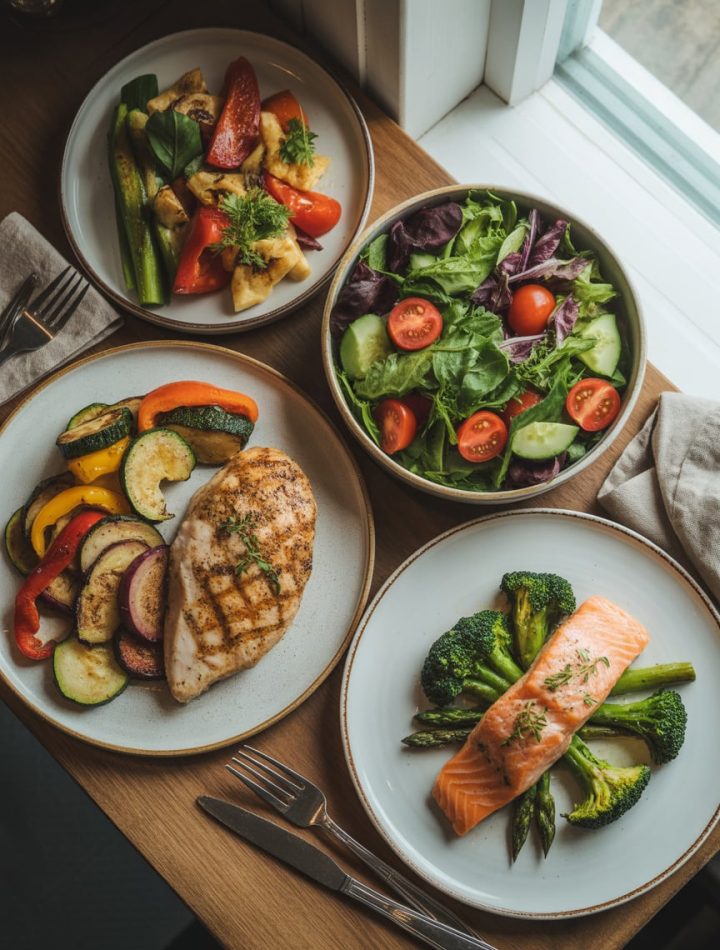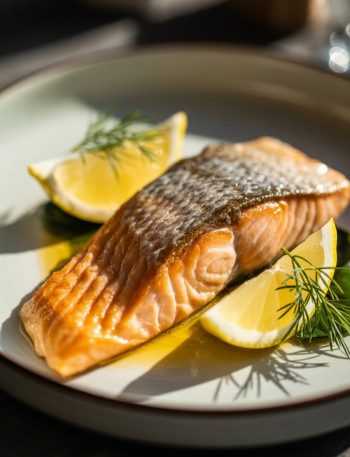Look, I’m not going to sugarcoat this (pun absolutely intended)—finding dinner recipes for diabetics that don’t taste like cardboard can feel like searching for a unicorn. But here’s the thing: eating diabetic-friendly doesn’t mean you’re sentenced to a lifetime of bland, boring meals that make you question all your life choices.
I’ve spent years experimenting in my kitchen, and honestly? Some of my best culinary wins happened after I started focusing on blood sugar-friendly cooking. Who knew that paying attention to carbs and fiber could actually make me a better cook? So let’s talk about some genuinely tasty easy diabetic dinner recipes that won’t spike your glucose or bore you to tears.
Why Diabetic-Friendly Doesn’t Mean Flavor-Free
Here’s what drives me nuts: people assume that healthy recipes for diabetics dinner automatically equals “no fun allowed.” Wrong. Dead wrong.
The secret sauce? It’s all about balance and smart substitutions. You’re not eliminating entire food groups—you’re just being strategic about portions and pairing. Think lean proteins, non-starchy vegetables, healthy fats, and yes, even carbs (the good kind). The goal is keeping your blood sugar steady while actually enjoying what’s on your plate.
Ever notice how restaurant meals leave you feeling sluggish? That’s because they’re loaded with hidden sugars and refined carbs. When you cook at home with diabetic-friendly ingredients, you control everything. Plus, your wallet will thank you 🙂
The Building Blocks of Great Diabetic Dinners
Before we jump into specific recipes, let’s talk strategy. Every solid diabete recipes for dinner easy should include these components:
The Power Trio:
- Lean protein (chicken, fish, turkey, tofu, legumes)
- Non-starchy vegetables (think greens, peppers, cauliflower, zucchini)
- Healthy fats (avocado, olive oil, nuts, seeds)
Smart Carb Choices:
- Quinoa instead of white rice
- Whole wheat pasta in moderation
- Sweet potatoes over regular potatoes
- Cauliflower rice (hear me out—it’s actually good when done right)
The beauty of this formula? You can mix and match endlessly without getting bored. It’s like having a culinary Lego set where everything fits together perfectly.
Sheet Pan Lemon Herb Chicken with Vegetables
This is my go-to weeknight dinner when I’m too tired to think. FYI, sheet pan meals are a diabetic’s best friend—minimal cleanup, maximum flavor, and portion control built right in.
What You’ll Need:
- 4 boneless, skinless chicken breasts
- 2 cups broccoli florets
- 2 cups cauliflower florets
- 1 red bell pepper, sliced
- 1 zucchini, sliced
- 3 tablespoons olive oil
- Juice of 2 lemons
- 4 garlic cloves, minced
- Fresh herbs (rosemary, thyme, or whatever you’ve got)
- Salt, pepper, and paprika
The Method:
Preheat your oven to 425°F. Toss all the vegetables with half the olive oil, half the lemon juice, salt, and pepper. Spread them on a large sheet pan. Place the chicken breasts on top, drizzle with the remaining olive oil and lemon juice, then season with garlic, herbs, and spices.
Pop everything in the oven for about 25-30 minutes until the chicken hits 165°F internally. The vegetables get slightly crispy on the edges, and the lemon keeps everything moist and flavorful.
Why It Works: You’re getting lean protein, tons of fiber from the veggies, and healthy fats from the olive oil. The carb count? Basically negligible. Plus, leftovers taste amazing cold or reheated.
Cauliflower Crust Pizza (Yes, Really)
I know what you’re thinking—cauliflower pizza sounds like something a fitness influencer made up to torture us. But IMO, this is one of those prediabetic dinner recipes that actually delivers.
Ingredients:
- 1 large cauliflower head, riced
- 1 egg
- 1 cup shredded mozzarella (part-skim)
- 2 tablespoons almond flour
- Italian seasoning, garlic powder
- Your favorite low-sugar pizza sauce
- Toppings: grilled chicken, mushrooms, spinach, olives, cherry tomatoes
How to Make It:
Rice your cauliflower (or buy it pre-riced because life’s short). Microwave it for 8 minutes, then squeeze out as much moisture as possible using a clean kitchen towel—this step is crucial, don’t skip it.
Mix the cauliflower with egg, cheese, almond flour, and seasonings. Press this mixture onto a parchment-lined baking sheet to form your crust. Bake at 450°F for 15 minutes until golden. Add your toppings and bake another 10 minutes.
The Verdict: Is it exactly like regular pizza? No. But is it satisfying, delicious, and way better for your blood sugar? Absolutely. The fiber from cauliflower slows down digestion, and you avoid the glucose spike from traditional dough.
Zucchini Noodle Shrimp Scampi
Zoodles (zucchini noodles) are controversial, I get it. Some people love them, others think they’re a sad pasta replacement. Here’s my take: they’re not trying to be pasta—they’re their own thing. And when you make this shrimp scampi, you won’t miss regular noodles.
Ingredients:
- 4 medium zucchinis, spiralized
- 1 pound large shrimp, peeled and deveined
- 4 tablespoons butter (or olive oil for dairy-free)
- 6 garlic cloves, minced
- Juice of 1 lemon
- Red pepper flakes
- Fresh parsley
- Salt and pepper
Cooking Instructions:
Spiralize your zucchini and lightly salt them, letting them sit for 10 minutes. This draws out excess moisture. Pat them dry.
In a large skillet, melt half the butter over medium-high heat. Add shrimp and cook 2-3 minutes per side. Remove and set aside. Add remaining butter, garlic, and red pepper flakes. Cook until fragrant (about 1 minute). Toss in your zoodles and sauté for 3-4 minutes—you want them tender but not mushy.
Return shrimp to the pan, add lemon juice and parsley, toss everything together. Done.
Nutrition Win: Shrimp is high in protein and low in carbs. Zucchini provides volume and fiber without spiking blood sugar. The healthy fats from butter help with satiety. This meal clocks in under 15g of carbs per serving.
Turkey and Black Bean Stuffed Peppers
Stuffed peppers are one of those dinner recipes for diabetics that feel fancy but are actually ridiculously simple. Plus, they’re naturally portion-controlled—you eat one or two peppers, and you’re done.
What You Need:
- 4 large bell peppers (any color)
- 1 pound lean ground turkey (93% lean)
- 1 can black beans, drained and rinsed
- 1 cup cauliflower rice
- 1 cup diced tomatoes
- 1 cup low-fat shredded cheese
- Cumin, chili powder, garlic powder, onion powder
- Salsa for serving
Preparation:
Cut the tops off your peppers and remove seeds. Arrange them in a baking dish.
Brown the turkey in a skillet, breaking it up as it cooks. Add cauliflower rice, black beans, tomatoes, and all your spices. Cook for 5 minutes until everything’s heated through and the flavors meld.
Stuff each pepper with the mixture, top with a bit of cheese, and cover the dish with foil. Bake at 375°F for 30 minutes. Remove foil and bake another 10 minutes to brown the cheese.
Why This Rocks: Black beans add fiber and plant-based protein. The cauliflower rice bulks up the filling without adding many carbs. You get about 30g of carbs per serving, but the fiber content means your blood sugar won’t spike dramatically.
Baked Salmon with Asparagus and Quinoa
Salmon is basically a superfood for diabetics. The omega-3 fatty acids help with inflammation, it’s packed with protein, and it pairs beautifully with fiber-rich sides.
Ingredients:
- 4 salmon fillets (4-6 oz each)
- 1 pound asparagus, trimmed
- 1 cup cooked quinoa
- 2 tablespoons olive oil
- 2 tablespoons balsamic vinegar
- Dijon mustard
- Garlic, minced
- Dill or parsley
The Process:
Mix olive oil, balsamic vinegar, Dijon mustard, and garlic to make a simple marinade. Brush it over your salmon fillets and let them sit for 15 minutes.
Arrange salmon and asparagus on a baking sheet. Roast at 400°F for 12-15 minutes until salmon flakes easily with a fork.
Serve over a bed of quinoa, drizzle any pan juices over everything, and garnish with fresh herbs.
Nutritional Breakdown: Quinoa is a complete protein with a lower glycemic index than rice. Asparagus is packed with vitamins and fiber. Salmon provides those essential fatty acids. You’re looking at around 35g of carbs, mostly from the quinoa, but it’s all high-quality, slow-digesting stuff.
Greek Chicken Bowls
Bowl meals are having a moment, and for good reason—they’re customizable, meal-prep friendly, and perfect for healthy recipes for diabetics dinner.
Components:
- Grilled chicken breast, cubed
- Romaine lettuce, chopped
- Cherry tomatoes, halved
- Cucumber, diced
- Red onion, thinly sliced
- Kalamata olives
- Feta cheese, crumbled
- Chickpeas, roasted
- Tzatziki sauce (homemade or low-sugar store-bought)
Assembly:
Season chicken with oregano, garlic powder, lemon juice, salt, and pepper. Grill or pan-sear until cooked through.
Layer your lettuce in bowls, top with all the veggies, add warm chicken and chickpeas, sprinkle with feta, and drizzle with tzatziki.
The Beauty Here: Everything’s fresh, flavorful, and loaded with nutrients. The chickpeas add plant-based protein and fiber. Feta gives you that salty, tangy kick without overdoing it. This meal is around 25g of carbs if you go easy on the chickpeas, and it keeps you full for hours.
Tips for Meal Prepping These Recipes
Want to know the real secret to sticking with diabete recipes for dinner easy? Meal prep. I know it sounds boring, but hear me out.
Sunday Strategy:
- Cook proteins in bulk (grill several chicken breasts, bake a few salmon fillets)
- Chop all your vegetables for the week
- Cook a big batch of quinoa or cauliflower rice
- Portion everything into containers
When dinner rolls around on a busy Tuesday, you’re not starting from scratch. You’re just assembling and reheating. The difference between success and ordering pizza? Usually just having components ready to go.
Storage Hacks:
- Use glass containers (they don’t stain or hold odors)
- Keep proteins separate from vegetables until you’re ready to eat
- Freeze extra portions of stuffed peppers or sheet pan meals
- Label everything with dates—trust me on this one :/
Smart Substitutions That Actually Taste Good
Look, I’m not going to tell you that every healthy swap is a perfect replacement. Some aren’t. But these? These work.
Carb Swaps:
- Spaghetti squash for pasta in Italian dishes
- Lettuce wraps instead of tortillas for tacos
- Mashed cauliflower instead of mashed potatoes (add cream cheese and nobody will complain)
- Almond flour or coconut flour for breading
Flavor Boosters:
- Fresh herbs over dried whenever possible
- Citrus juice and zest for brightness without sugar
- Spices like smoked paprika, cumin, and coriander for depth
- Nutritional yeast for a cheesy flavor (sounds weird, tastes great)
The goal isn’t deprivation—it’s making choices that support your health without making you miserable. Because what’s the point of managing diabetes if you’re not actually enjoying your life?
Common Mistakes to Avoid
I’ve made all these mistakes so you don’t have to. You’re welcome.
Going Too Low-Carb Too Fast: Your body needs carbs for energy. Cutting them out completely can backfire. Aim for balance, not elimination.
Forgetting About Portions: Yes, nuts are healthy. No, eating an entire container in one sitting isn’t great for your blood sugar. Portion control matters even with “good” foods.
Over-Relying on “Diabetic” Products: A lot of sugar-free or diabetic-friendly packaged foods are loaded with artificial sweeteners and additives. Real food is almost always better.
Skipping Meals: This messes with your blood sugar more than you’d think. Consistent meal timing helps keep everything stable.
The Bottom Line on Diabetic Dinner Success
Here’s what I’ve learned after years of cooking diabetic-friendly meals: it’s not about perfection. Some nights you’ll nail it with a beautiful salmon dinner. Other nights you’ll throw together a simple turkey and veggie scramble. Both are totally fine.
The key to sustainable prediabetic dinner recipes and diabetic eating is finding what works for YOUR life, YOUR taste preferences, and YOUR schedule. These recipes are starting points—feel free to modify them, swap ingredients, and make them your own.
Will every meal be Instagram-worthy? Nope. Will you occasionally order takeout or eat something that spikes your blood sugar? Probably. And that’s okay. Progress over perfection, always.
The real win is having a toolkit of reliable recipes that you actually enjoy making and eating. When you’ve got that, managing diabetes through diet stops feeling like a chore and starts feeling like just… cooking dinner. Which is kind of the whole point, right?
Now get in that kitchen and make something delicious. Your taste buds and your blood sugar will both thank you.





